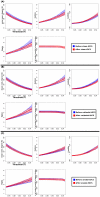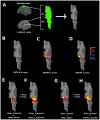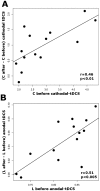Reorganizing the intrinsic functional architecture of the human primary motor cortex during rest with non-invasive cortical stimulation
- PMID: 22303478
- PMCID: PMC3267735
- DOI: 10.1371/journal.pone.0030971
Reorganizing the intrinsic functional architecture of the human primary motor cortex during rest with non-invasive cortical stimulation
Abstract
The primary motor cortex (M1) is the main effector structure implicated in the generation of voluntary movements and is directly involved in motor learning. The intrinsic horizontal neuronal connections of M1 exhibit short-term and long-term plasticity, which is a strong substrate for learning-related map reorganization. Transcranial direct current stimulation (tDCS) applied for few minutes over M1 has been shown to induce relatively long-lasting plastic alterations and to modulate motor performance. Here we test the hypothesis that the relatively long-lasting synaptic modification induced by tDCS over M1 results in the alteration of associations among populations of M1 neurons which may be reflected in changes of its functional architecture. fMRI resting-state datasets were acquired immediately before and after 10 minutes of tDCS during rest, with the anode/cathode placed over the left M1. For each functional dataset, grey-matter voxels belonging to Brodmann area 4 (BA4) were labelled and afterwards BA4 voxel-based synchronization matrices were calculated and thresholded to construct undirected graphs. Nodal network parameters which characterize the architecture of functional networks (connectivity degree, clustering coefficient and characteristic path-length) were computed, transformed to volume maps and compared before and after stimulation. At the dorsolateral-BA4 region cathodal tDCS boosted local connectedness, while anodal-tDCS enhanced long distance functional communication within M1. Additionally, the more efficient the functional architecture of M1 was at baseline, the more efficient the tDCS-induced functional modulations were. In summary, we show here that it is possible to non-invasively reorganize the intrinsic functional architecture of M1, and to image such alterations.
Conflict of interest statement
Figures





Similar articles
-
Introducing graph theory to track for neuroplastic alterations in the resting human brain: a transcranial direct current stimulation study.Neuroimage. 2011 Feb 1;54(3):2287-96. doi: 10.1016/j.neuroimage.2010.09.085. Epub 2010 Oct 13. Neuroimage. 2011. PMID: 20932916
-
Modulating cortico-striatal and thalamo-cortical functional connectivity with transcranial direct current stimulation.Hum Brain Mapp. 2012 Oct;33(10):2499-508. doi: 10.1002/hbm.21380. Epub 2011 Sep 16. Hum Brain Mapp. 2012. PMID: 21922602 Free PMC article.
-
Modulating functional connectivity patterns and topological functional organization of the human brain with transcranial direct current stimulation.Hum Brain Mapp. 2011 Aug;32(8):1236-49. doi: 10.1002/hbm.21104. Epub 2010 Jul 6. Hum Brain Mapp. 2011. PMID: 20607750 Free PMC article.
-
Changes in resting state functional connectivity after repetitive transcranial direct current stimulation applied to motor cortex in fibromyalgia patients.Arthritis Res Ther. 2016 Feb 3;18:40. doi: 10.1186/s13075-016-0934-0. Arthritis Res Ther. 2016. PMID: 26842987 Free PMC article.
-
Transcranial direct current stimulation over the primary motor cortex during fMRI.Neuroimage. 2011 Mar 15;55(2):590-6. doi: 10.1016/j.neuroimage.2010.11.085. Epub 2011 Jan 4. Neuroimage. 2011. PMID: 21211569
Cited by
-
Je pense donc je fais: transcranial direct current stimulation modulates brain oscillations associated with motor imagery and movement observation.Front Hum Neurosci. 2013 Jun 6;7:256. doi: 10.3389/fnhum.2013.00256. eCollection 2013. Front Hum Neurosci. 2013. PMID: 23761755 Free PMC article.
-
Transcranial Direct Current Stimulation Targeting Primary Motor Versus Dorsolateral Prefrontal Cortices: Proof-of-Concept Study Investigating Functional Connectivity of Thalamocortical Networks Specific to Sensory-Affective Information Processing.Brain Connect. 2017 Apr;7(3):182-196. doi: 10.1089/brain.2016.0440. Brain Connect. 2017. PMID: 28142257 Free PMC article. Clinical Trial.
-
Activation response and functional connectivity change in rat cortex after bilateral transcranial direct current stimulation-An exploratory study.J Neurosci Res. 2021 May;99(5):1377-1389. doi: 10.1002/jnr.24793. Epub 2021 Jan 28. J Neurosci Res. 2021. PMID: 33511664 Free PMC article.
-
Can transcranial electrical stimulation improve learning difficulties in atypical brain development? A future possibility for cognitive training.Dev Cogn Neurosci. 2013 Oct;6:176-94. doi: 10.1016/j.dcn.2013.04.001. Epub 2013 Apr 17. Dev Cogn Neurosci. 2013. PMID: 23770059 Free PMC article. Review.
-
The association of motor imagery and kinesthetic illusion prolongs the effect of transcranial direct current stimulation on corticospinal tract excitability.J Neuroeng Rehabil. 2016 Apr 15;13:36. doi: 10.1186/s12984-016-0143-8. J Neuroeng Rehabil. 2016. PMID: 27079199 Free PMC article.
References
-
- Rasmussen T, Penfield W. The human sensorimotor cortex as studied by electrical stimulation. Fed Proc. 1947;6:184. - PubMed
-
- Sanes JN. The relation between human brain activity and hand movements. Neuroimage. 2000;11:370–374. - PubMed
-
- Donoghue JP, Leibovic S, Sanes JN. Organization of the forelimb area in squirrel monkey motor cortex: representation of digit, wrist, and elbow muscles. Exp Brain Res. 1992;89:1–19. - PubMed
-
- Sanes JN, Wang J, Donoghue JP. Immediate and delayed changes of rat motor cortical output representation with new forelimb configurations. Cereb Cortex. 1992;2:141–152. - PubMed
-
- Sanes JN, Donoghue JP. Plasticity and primary motor cortex. Annu Rev Neurosci. 2000;23:393–415. - PubMed
Publication types
MeSH terms
LinkOut - more resources
Full Text Sources
Molecular Biology Databases

